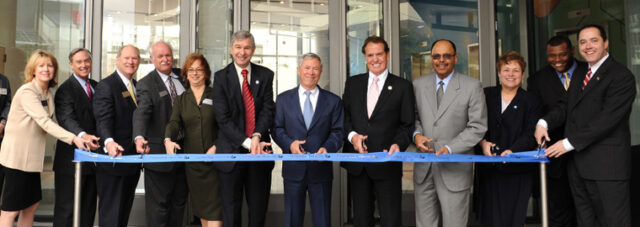On March 29, Georgia State University opened its new Parker H. Petit Science Center, a 350,000 square-foot facility that will advance scientific understanding, health innovation and health education.
The facility, located at the intersection of Decatur Street and Piedmont Avenue, will house laboratories, offices and classrooms, and will be home to university research and education programs in biology, chemistry, nursing, nutrition, physical and respiratory therapies, public health, as well as the Neuroscience Institute.
“We celebrate years of hard work that got us to this occasion, and we look to the future possibilities of the vitally important education and research that will take place at this fine facility,” said President Mark Becker. “Let us dedicate this state-of-the-art house of learning, research and technology, designed and built to help us and those who come after us to meet some of our world’s greatest challenges in health and in the sciences.”

The facility is named for Parker. H. “Pete” Petit in recognition of his leadership gift to GSU. He received his master of business administration degree from Georgia State in 1973 in order to build his business acumen and today serves as chairman and chief executive officer of MiMedx Group, Inc., an integrated developer, manufacturer and marketer of biomaterial-based products.
“I believe that the science center will act as a catalyst in helping students to set their career goals, and when you add the exceptional faculty in the disciplines which will use the center, we have the assets to make the sciences a new growth element for Georgia State University,” Petit said.
The new facility includes vastly improved research and office space on the fifth through ninth floors, including critical core facilities needed for exploration. Officials hope that the new science center will help attract new researchers to Georgia State, and the new building will open up more space on campus for current researchers.
The center will be home to scientists from the university’s Center for Biotechnology and Drug Design, who are working on treatments and diagnostics for diseases, including cancer. It will also house biologists researching a broad range of areas, including those of the Molecular Basis of Disease initiative, exploring genetic anomalies, cancer, HIV/AIDS, gastrointestinal disorders, infectious diseases, and other topics on the molecular and cellular level.
The science center will serve as the headquarters for the university’s Neuroscience Institute, where researchers’ work into understanding the mechanisms and behaviors of the brain will potentially lead to better ways to overcome disorders ranging from autism, to post traumatic stress disorder and Alzheimer’s disease.
The science center will house critical facilities called advanced biotechnology core facilities, which are necessary for advanced research, such as a mass spectrometer, cell sorters, a gene chip reader, as well as confocal, electron and atomic force microscopes used to view cellular processes.
The facility will house Georgia State’s Bio-Safety Level 4 lab – one of the few university-based BSL-4 labs in the country – where Julia Hilliard will work on Herpes B virus, and a BSL-3 lab where Margo Brinton will continue work on West Nile virus.
Additionally, the building will house a “visualization wall” – a large, 200-million pixel array of computer screens which scientists can use to view vast amounts of data in large-scale projects as wide ranging as public health, where researchers might be interested how disease spreads in an urban area, to computer science, where researchers might be curious as to how large screens change the way humans interface with computers.
The 10-story building will include six general classrooms and 32 department-specific teaching labs and classrooms from the first through fourth floors, including a more than 100-seat auditorium on the first floor. More than 2,000 students are expected to pass through the building during class changes on a daily basis.
The new building will allow the university to graduate nurses well prepared to manage and deliver high-tech health care. Several rooms in the new science center are equipped with interactive patient simulators and space that replicates a 10-bed hospital unit. The new facility also will include space for the respiratory therapy labs, physical therapy labs, as well as sports nutrition labs.
The first occupants of the new building are expected to move into the facility in May, with laboratory moves from different parts of campus into the science center during the summer.
Archived from the Internet Wayback Machine at https://web.archive.org/web/20110401223936/http://www.gsu.edu/40937.html.
Archived to this website on 7/24/21.